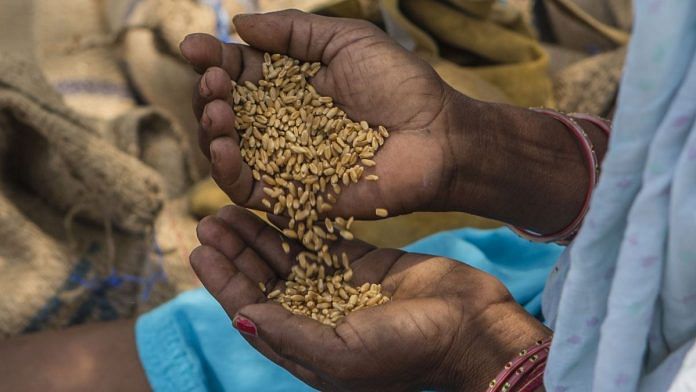New Delhi: Retail prices of wheat and its derived processed food items like pasta, noodles and semolina are likely to see a fall as the Food Corporation of India (FCI) is set to slash the reserve price of the wheat it sells.
Currently, the market price of wheat is Rs 22 per kg, compared to Rs 35/kg in March. Wheat flour prices are around Rs 28/kg now, cheaper from Rs 30/kg three months ago.
Officials in the Union Ministry of Consumer Affairs Ministry said the government will soon reduce the reserve price at which the FCI sells wheat to private buyers under the Open Market Sale Scheme (OMSS) — the second time in six months.
The move aims to promote increased purchase by private buyers under OMSS, which came down to nil in June, said the officials, who didn’t wish to be identified. The FCI has run out of storage facilities, and needs to offload the excess stock, they added.
The bumper rabi produce procured in many states has added to the FCI’s woes because the wholesale market price of wheat is less than the central agency’s rate.
Under OMSS, the FCI currently sells ‘Grade A’ wheat at Rs 2,135/quintal and the ‘Grade B’ at Rs 2,080/quintal. However, these rates are significantly higher than the current market prices of Rs 1,850-1,920/quintal.
A consumer affairs ministry official said the wheat prices under the scheme can be reduced to Rs 1,640/quintal for ‘Grade A’. “Also, for purchase outside Punjab, Haryana and Madhya Pradesh the currently levied freight/road transport charge will also be waived,” said the official.
“Due to higher prices than the market prices, there has been a decline in wheat sale under OMSS from 33,980 metric tonnes (in March) to 25,520 MT in April and 1,810 MT in May, with no sales in June,” said a second ministry official.
The nationwide Covid-19 lockdown was enforced beginning 25 March. It was eased considerably last month.
“With this rate, it will be impossible to meet the annual offload target of 150 lakh metric tonnes (LMT) through this scheme. Also, this has created a storage shortage and costing problem due to bumper rabi wheat produce procured in many states,” added the second official.
In January, the wheat reserve price was slashed to Rs 2,135/quintal and Rs 2,080/quintal for the two grades of grain. Under the OMSS, the price of rice was also cut to Rs 2,250/quintal from Rs 2,785/quintal in January this year.
Also read: They vowed never to return. But no savings, no jobs & debt force migrants back to Mumbai
Why the need for a second cut
According to the officials, the wheat price will be slashed a second time this year because there was an increase in the foodgrain’s offtake after the first cut, but it came to a standstill soon due to the Covid pandemic.
Meanwhile, the wheat stock touched a record high due to an overwhelming procurement in the rabi season even though it has been distributed under the Pradhan Mantri Garib Kalyan Yojana (PMGKY).
Under the central scheme, the government has been giving free monthly foodgrain, including 5 kg wheat each, to poorer sections of the society since March amid a livelihood crisis. The service, via the public distribution system (PDS), will be effective until November.
The central government has been looking to offload excess foodgrain in stocks in the central pool as it has almost exhausted its capacity to store grains in permanent structures and has to choose a covered and plinth mode of storage to store grains.
FCI has procured almost 260 LMT of foodgrain this season. The total foodgrain stock in the central pool increased from 569.39 LMT in April to 832.69 LMT in June 2020, with a buffer stock requirement of just 411.20 LMT. The current storage capacity in the country is around 880 LMT, which will soon run short.
The wheat stock in the central pool in June 2020 stood at 558.25 LMT. In the year-ago period, this number was at 465.60 LMT.
The rice offtake from the central pool, however, has increased with the increased disbursal under the PMGKY.
‘How this will affect wheat product prices’
Sanjay Puri, president of the Roller Flour Mills Federation, said the fall in wheat prices has come due to record rabi wheat harvest and increased PDS disbursal of free foodgrain.
“Reduction in wheat prices through OMSS will effect a further cut in the cost of flour, semolina, pasta and noodles along with other processed foods,” said Puri.
According to him, the government decision will also help other sections of society “with cheaper flour prices rather than just supporting PDS beneficiaries with over and above free foodgrain supply every month”.
Also read: India’s Covid-ravaged states seek more funds from Modi govt




आप ने एक खबर पोस्ट की सरकार गैहू का मुल्य घटा सकती है।
जबकि सरकार 2135 में बेच रहीं हैं।
आपके पास किस अधिकारी ने कहा
स्पष्ट करे
Why not just GIVE to those who are still starving – food situation is still bad, just look in villages.